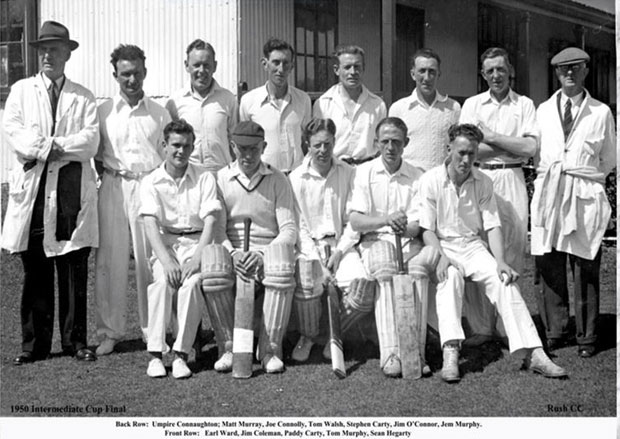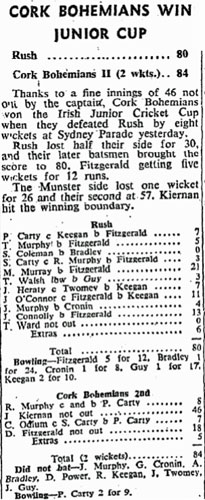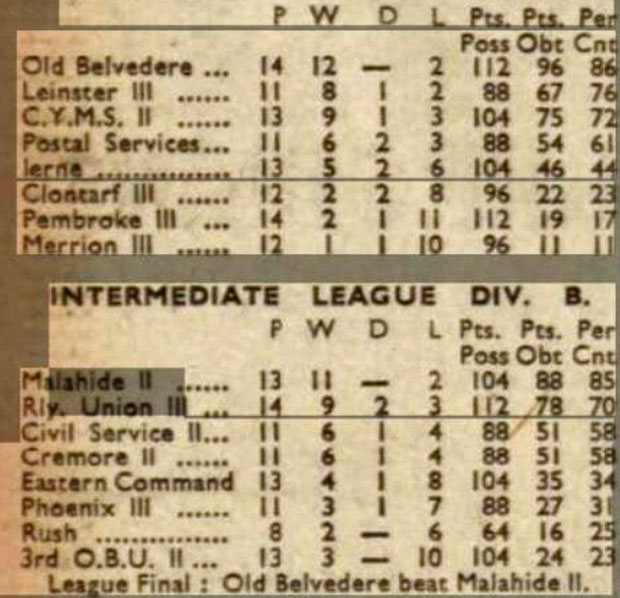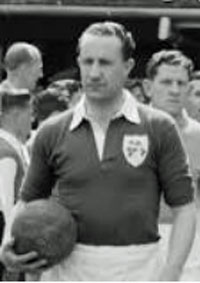In 1950, Rush played in the Intermediate B Section of the Leinster League, and that season there was the added incentive that the winners of the Intermediate Cup would represent the Dublin Zone in the Irish Junior Cup which was the brainchild of K. P. Tanham, the Railway Union member of the Leinster Cricket Union Executive.
This proposed competition was discussed at a meeting of the ICU in June 1950, and the delegate from the NCU indicated that his union could not support the idea because the fixture list was already full. The NWCU adopted a similar position, with the result that the competition was never endorsed by the ICU and is a possible reason that the name of the competition was changed to the Irish Junior Cup.
Undaunted, K. P. Tanham persevered, and thirty-eight clubs, representative of six zones, three in Munster and three in Leinster were to take part. The teams in the Intermediate B League that season were Malahide 11, Railway Union 111, Civil Service 11, Cremore 11, Eastern Command, Phoenix 111, and 3rd OBU. Old Bevedere CC which was formed by recent past pupils of Belvedere College, affiliated to the League in February 1950 and was a significant addition to the A Section of the Intermediate League.

The draw for the Intermediate Cup was made at the General Meeting of the Leinster Cricket League, and Rush was drawn away to Cremore, with all first-round games to be played on the weekend of 17 June 1950. In that game, Cremore batted first, never recovered from a bad start, and they were all out in less than an hour for 23 runs. The brilliant bowling of Jim Murphy (5 wickets for 2 runs) and Stephen Carty (3 for 19) was 'mainly responsible' for the collapse. The Drogheda Independent singled out the 'inspired play of both Sean Heraty and Joe Connolly' as a feature of the Rush fielding. The required runs were obtained in a short time, but Rush continued to bat until the score was 116 for 3. The main contributors to Rush's score were Paddy Carty (17), J. Murphy (14), Con Martin (54) and J. O'Connor (29*).
The results of the League games which Rush played during this season have been difficult to trace, and if a result was not published in the newspapers, unfortunately there is no other source from which they can be obtained. The first league game of the season was played against the Eastern Command and based on the League table which was published in July, it can be deduced that Rush won, because at that stage Eastern Command had lost all its games. Rush played Railway Union on 26 June and was beaten by 14 runs. The only Rush player to receive a mention was Con Martin who took 5 wickets for 14 runs.
In the League table, which was published in the Evening Herald on 5 July, Rush had played 6 games, won 2, lost 4 and was second last in the league with a total of 16 points. The League leaders were Malahide 11 with 5 wins and 1 loss, and a total of 40 points. It is noteworthy that 8 points were allocated for a win and 5 points for a rain-draw.
In July, Rush and Malahide played a close game in the League which resulted in a win for Malahide on a score of 84 for 8 to Rush's 83. In the cup campaign by a process of deduction and the personal recollection of Tom Murphy who played for Rush in these games, it was possible to identify the teams that Rush beat on its way to the final.
Most of the first -round results were published on the Sunday Independent, and based on the draw which was made in February, Rush was scheduled to meet the winners of Clontarf and Malahide. Clontarf beat Malahide on a score of 89 to 88 and became Rush's opponents in the second round. In the semi-final, Rush played Pembroke, and Tom Murphy had a clear recollection of this game because he scored a century to enable Rush to reach the final.
The final of the Intermediate Cup between Rush and Phoenix 111 was played at Clontarf on Saturday, 29 July 1950. Rush won the toss and batted first. P. Carty (21) and T. Murphy scored runs at a brisk pace, until Murphy (17) was out to a catch at slip when the score was 28. T. Walsh (31) was out after a splendid knock when the score was 99. The last wicket stand between J. O'Connor and J. Ward produced 26 runs, with 'O'Connor at last revealing true form with a brilliant 24'. Rush's total for the innings was 135 runs. In reply, Phoenix started well, but S. Carty took the first 4 wickets for 10 runs to leave Phoenix in deep trouble with the score standing at 34 for 4. A stand between Bex and Durnan brought the score to 69 until J. Murphy took 3 quick wickets in a superb spell of bowling, and 'Phoenix were a beaten side. T. Murphy took the last two wickets and Phoenix was all out for 78 runs. The report in the Drogheda Independent described the game as being 'highly exciting', but that description is difficult to justify when the margin of victory was 57 runs.

This result cleared the win for the Irish Junior Cup competition to commence in earnest. The preliminary round draw was as follows: Longford (Leinster Division Winners) versus the winners of the game between Ferns (Wexford Division Winners) and Rush (Dublin Division Winners). The preview in Irish Independent to the game between Rush and Ferns mentioned that winners would be playing Longford 'where few outsiders even knew that the game was played'.
The game between Phoenix and Rush may not have merited the epithet, 'exciting', but the game between Rush and Ferns which was played at CYMS, Terenure on 5 August 1950 was definitely in this category. Ferns won the toss and opted to field first on what 'looked like a batsman's wicket', but appearances were deceptive. P. Carty and T. Murphy (14) were both caught by the wicketkeeper off balls 'that kicked from a good length'. J. Coleman (25) and S. Carty brought the score from 22 to 44 when Carty was out for 9. Con Martin (7) was caught and bowled when the score was 63. Murray (11) and J. Murphy added a valuable 20 runs, and the last Rush wicket fell for 93 runs.
In reply, Ferns started badly, and lost 3 wickets for 15 runs, but a superb stand between Maher (33) and Lawless (24) brought the score to 51. When Lawless was out, Ferns began to struggle, and its final score was 87 runs. Best of the bowlers for Rush were T. Murphy (4 for 13), S. Carty (4 for 24) and J. Murray (2 for 27). As would be expected of a Fingal team, 'the Rush fielding was very keen, and M. Murray in particular did some very fine stopping.'
The next round of the competition between Rush and Longford was played at Sydney Parade on 10 August. Longford batted first but they were always struggling for runs against the Rush bowling attack and were all out for 59 runs. S. Carty (3 for 22), J. Murphy (for 25) and P. Carty (3 for 1) were the most successful bowlers for Rush. In reply, Rush got the necessary runs for the loss of 4 wickets with J. Coleman on 29 not out, the pick of the batsmen. In summing up this game, the Longford Leader reporter expressed the opinion that it was too much for Longford to hope for a win against a Rush X1, who 'were veterans in the art of cricket', but the consolation for Longford was that it had 'a most enjoyable day's sport and had the pleasure of playing on a proper cricket grounds.' Another positive by-product of this game was that Rush agreed to visit Longford for a game in September.
The semi-final of the Irish Junior Cup between Rush and County Galway was played at Santry on 19 August 1950. Rush batted first and against the bowling of Derrick Kennedy, a former Irish International, found runs hard to come by. The principal contributors to Rush's score of 68 were T. Murphy (10), T. Carty (10) and J. O'Connor (13*). Kennedy's bowling figures were 8 wickets for 32 runs. In reply, Galway found runs equally hard to come by, with Kennedy (25) and M. J. O'Rourke (17) being their most successful batsmen. Rush's bowling attack of S. Carty (5 for 21), T. Murphy (3 for 1) and J. Murphy (2 for 19), supported by 'very keen fielding', ensured that Galway ended up on 55 runs, 13 short of Rush's total.
In the interests of accuracy, it is necessary to correct the Irish Times's report on 21 August 1950 which stated that Rush had won the Irish Junior Cup. This game was in fact the semi-final and the final was between Rush and Cork Bohemians. The final was arranged to be played at Crumlin on Saturday, 26 August, but it was rained off, and the game was re-fixed for the following day at Sydney Parade.

Rush batted first, and in one of those unfortunate batting collapses which tended to bedevil Fingal League teams on big occasions, it had lost half of its wickets for 30 runs. The remaining batsmen especially Murray (21), J. O'Connor (11) and J. Connolly (13) managed to bring the score up to 80 runs all out. D. Fitzgerald was the bowling star for Cork, and he ended with figures of 5 wickets for 12 runs. In a situation such as this, it is essential that wickets are taken early, but this did not happen, and the first Bohemians' wicket did not fall until the score was 26 and the second one fell at 57. The Bohemians Captain, Jim Kiernan, a brother of Tom Kiernan, the rugby international, scored an unbeaten 46, and the target score was achieved for the loss of 2 wickets. The only successful bowler for Rush was Pat Carty who took 2 wickets for 9 runs.
The consensus on the Irish Junior Cup was that it had been a successful initiative, and K. P. Tanham's 'organising genius' was praised at the Leinster Cricket Union's AGM. The competition had the potential to raise the profile of cricket throughout the country, and to assist in the revival of the games in areas where cricket had been played in former times. For the players of Rush CC, it was a wonderful adventure because it provided an opportunity to play against teams that they have never played before and to test their skills in different conditions and surroundings. The only slight reservation about the competition related to its scope. It may have been too ambitious because with cup competitions taking precedence over league games and some clubs not playing on Sundays, it had an impact on Rush's involvement in the Intermediate League. When the final league tables were published in September 1950, Rush had only played 8 games whereas Railway Union which finished second in the League had played 14 games, and Malahide, the winners, and 3rd OBU, the last team, had both played 13 games. For the record, Rush won 2 games, lost 6 games and its final percentage was 25%.
Although there is no mention of Rush playing Fingal League games in the 1950 season, nevertheless, it hosted the Cup Final between Walshestown and Clonard at Kenure Park on 20 August; the game was scheduled to start at 2.30 p.m. sharp and the admission was 6d.
Up to this point, the emphasis has been on cricketing matters, but Rush CC continued its involvement in the social life of the town by organising dances monthly from May to September inclusive. There was a tried and tested formula for the dances so each month the arrangements remained unchanged for the most part. The venue was the Palladium, the music was provided by the Carlton Dance Band, dancing was from 9.00 p.m. to 2.00 a.m., and admission (including tax) was 3s 6d. There was a slight change on one of the advertisements which included the exhortation - 'Enough said - be there!'.

The final dance of the season was scheduled to end at 1.00 p.m. rather than 2.00 p.m. and when the Table Tennis Club took over the organisation of the dance from the start of October onwards, it also had a 1.00 p.m. finishing time. The end of the season did not end the club's involvement in social life in Rush and traditionally it organised two Whist Drives towards the end November and early December. The Whist Drives were held at Red Island Holiday Camp in Skerries, admission was 3s 6d, and the prize for the top score was £20. There were almost 100 tables occupied at the event which was held on 26 November and the Whist Drive on 10 December was 'dubbed the biggest event of the week in Skerries'.
A review of 1950 shows that Rush CC was an integral element of the community in which it was based. It provided worthwhile sporting activity during the cricket season and social activities throughout the year. The team had won the Intermediate League and played with distinction in the inaugural Irish Junior Cup by reaching the final.
Its defence of the Intermediate Cup in 1951 was going to have an added local dimension because its near neighbours, Balrothery, had been promoted to the Intermediate League for the new season, and as it happened, the two teams met in the final of the Intermediate Cup in 1951, but that is a story for another day.
This survey of one year in the life of a cricket club showed that people placed such a high value on the game they were willing to invest a huge amount of time and energy throughout the year in ensuring that cricket would continue to develop and prosper in Rush.
Notes
1. P. J. Doolan's assistance in the preparation of this article is acknowledged with thanks.
2. Thanks to Joe Curtis for the photographs
Additional Notes: James O'Connor was father of David O'Connor, President of Cricket Ireland in 2019 and long-serving President of North County CC. Joe Connolly was father of Joe Connolly Jnr, the famous cricket, and hockey umpire Tom Murphy, a legendary Fingal cricketer, played for Knockbrack, Man-O-War, Walshestown, Balrothery and Rush. He made his debut in 1938 and played his last game in 1992.
Con Martin Profile

Con Martin was one of the great Irish players of the last century and was best known for scoring a penalty against England at Goodison Park in September 1949 - England's first home defeat to a non-UK side.
The Dubliner played for Drumcondra, Glentoran, Leeds United, Aston Villa and Waterford. He also played for both the Ireland teams under the FAI and IFA administration. He won 30 caps for the Republic of Ireland and six for Northern Ireland.
Martin played Gaelic football with St Maur's in Rush and St Mary's Saggart before going on to represent Dublin and featuring in their Leinster Championship win in 1941. Although best known as a centre-half, he made his international debut for the Republic of Ireland as a goalkeeper and played close to a complete season in goal for Aston Villa.
He helped Drumcondra to FAI Cup success in 1946, then signed by Glentoran later that year signed for Leeds United in December 1946. He joined Aston Villa two years later before signing for Waterford United in 1956.
He later had a spell as player-manager of Dundalk FC. Martin's son Mick Martin went on to become a senior international footballer and grandson Owen Garvan has been capped at Under-21 international level for Ireland.
Sources: RTE Website, Wikipedia
